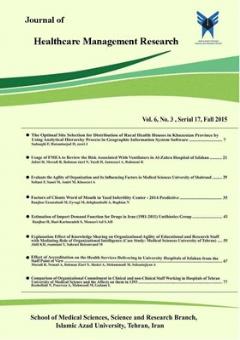Comparing the Normal Familiesʼ and the Families with Special Patientsʼ Consumerist Lifestyles in Arak City, Iran
Subject Areas : medical documentsMohammad Montazeri 1 , Omid Ali Ahmadi 2 * , mohamad hosein asadi 3
1 - PhD student in Economic Sociology and Development, Faculty of Humanities, Ashtian Branch, Islamic Azad University, Ashtian, Iran
2 - Assistant Professor, Department of Sociology, Faculty of Humanities, Ashtian Branch, Islamic Azad University, Ashtian, Iran
3 - Assistant Professor, Department of Sociology, Faculty of Humanities, Ashtian Branch, Islamic Azad University, Ashtian, Iran
Keywords: Lifestyle, consumerism, special patients, social welfare, social support,
Abstract :
Introduction: The occurrence of a specific chronic disease is considered one of the unforeseen changes that severely affects the family lifestyle. The aim of this study is to investigate the effects of the occurrence of a specific disease on family consumption and lifestyle and compare it with normal families.
Methods: This study was conducted using a cross-sectional survey method on two statistical populations including heads of normal families and families with special patients. The sample size was calculated to be 384, which were selected from normal families and families with special patients by combining cluster sampling and non-proportional classification. The data collection tool is a researcher-made questionnaire with face validity. The analyses were conducted in SPSS software and the reliability of the questionnaire variables was evaluated by Cronbach's alpha as higher than 0.7. In the inferential statistics section, regression, correlation, and analysis of variance tests were used.
Results: The results of the study show that consumer lifestyle in four dimensions (leisure and entertainment, nutrition, body management, and clothing and fashion) is different in normal families and families with special patients, but this difference is not significant based on the type of disease. It was also found that the individual characteristics of the patient have an effect on the consumer lifestyle of families with special patients. The results indicate that the economic capital and employment rate of normal families are more than 3 times that of special patients. This weakness of special patients' families is also visible in the dimension of social capital. Also, special patients' families are twice as likely to live in poorer areas of the city compared to normal families, and their house size is smaller compared to normal families.
Conclusion: The results of the present study confirm that the illness of a family member with a specific disease severely weakens the family's well-being and the quality of lifestyle. Accordingly, two direct and indirect support strategies are proposed to support these families. Providing financial assistance, paying subsidies, paying for pharmaceutical and laboratory costs, and assisting with insurance can be part of direct support. Indirect support is also related to the possibility of their employment and earning an independent income, and the possibility of marriage and starting a family for single patients or their unmarried children.
1- Dehkhoda, Ali Akbar et al. Dehkhoda Dictionary, Tehran: Tehran University Printing and Publishing Institute; 1998.
2-Thyra C. Uth. Definition of Lifestyle and its Application to travel behavior. PhD student. Department at the Aarhus school of Business. Aalborg, Denmark; 1996.
3- Feist, J.; Gregory J., Feist. Theories of Personality, Yahya Seyed Mohammadi, Tehran: Nashravan Publishing House; 1992.
4- Valizadeh, Mohammad Javad. “The Necessity of Presenting an Indigenous Iranian Islamic Definition of Lifestyle”, Cultural Engineering, Issue 75, Tehran: Supreme Council of Cultural Revolution; 2013.
5- Hassan Doost Farkhani, Hadi; Rezaei, Omid. “Investigating the Ideal Model of Lifestyle from the Perspective of the Islamic School”, Marefat, Issue 186, Qom: Imam Khomeini Educational and Research Institute; 2013.
6- Baingani, Bahman; Irandoost, Seyed Fahim; Ahmadi, Sina. Lifestyle from a Sociological Perspective, An Introduction to the Recognition and Analysis of the Concept of Lifestyle, Cultural Engineering, Year 3, 2013; 22: 10-26.
7- Mahdavi Kani, Mohammad Saeed. Religion and Lifestyle, Tehran: Imam Sadegh University; 2008.
8- ISNA, Iranian Students News Agency. Everything you need to know about special diseases, available at isna.ir/xdLBw4; 2022.
9- Afshar, Amin. Statistical overview of the status of special diseases in the world; 2021. available at: https://drnext.ir/blog/rare-disease-facts/
10- Mohseni, Manouchehr. Medical sociology, Tehran: Tahouri Publications; 2019.
11- Giddens, Anthony. Sociology (4th Ed), Cambridge, UK: Polity Press; 2001.
12- Grabb, E. G. Social inequality: Classical and contemporary theorists. Holt, Rinehart and Winston of Canada; 1984.
13- Keyvan Ara, Mahmoud. Principles and foundations of medical sociology, Isfahan, Isfahan University of Medical Sciences and Health Services; 2007.
14- Cockerham, W. & etal. Health lifestyles and political ideology in Belarus, Russia, and Ukraine. Social science medicine, 2006; 62(7): 1799-1809.
15- Cockerham, W. C. Health lifestyle theory and the convergence of agency and structure. Journal of health and social behavior, 2005; 46(1): 51-67.
16- Ghorbanzadeh, Sakineh. Studying the relationship between lifestyle and driving behavior among young people in Tehran province. Master's thesis, University of Mazandaran; 2007.
17- Bourdieu, Pierre. Distinction: A Social Critique of Taste Judgments, Translated by: Hassan Chavoshian, Tehran: Sales Publishing House; 2011.
18- Giddens, Anthony. The construction of society, translator: Akbar Ahmadi, Tehran: Alam Publishing; 2016.
19- Qaderi, Maleki; Maleki, Amir; Haqjoo, Majid. Structural-capital determinants of lifestyle for coping with chronic diseases, Iranian Journal of Sociology, 2018; 18(3): 110-142.
20- Asadi, Masoud. Meta-analysis of factors affecting the quality of life of special patients, Hormozgan Medical Journal (61st series), 2011; 1.
21- Noubahar, Monir. Lifestyle Changes from the Perspective of Patients Undergoing Hemodialysis: Content Analysis. Journal of Qualitative Research in Health Sciences, 2017; 6(4): 384-373.
22- Nouraldini, Seyed Sadruddin, Sadeghi Saqdal, Hossein, Asari Arani, Abbas, and Faraji Dizji, Sajjad. The Economic Impact of Chronic Diseases on Iranian Household Costs and Income. Economic Research and Policies, 2021; 29(98): 207-241.
23- Yazdian, Ghodsi, Karimi, Iraj, and Tofighi, Shahram. A comparative study of health management of special patients and a proposal of a model for Iran. Research in Medicine, 2008; 32(4): 271-278.
24- Heidari, Hamed; Akherati, Mahmoud; Nikpour, Sadegh. Study and Comparison of Lifestyle Components and Quality of Life in Patients with Chronic Diabetes and Hypertension with Healthy Individuals, Third International Conference on Psychology, Educational Sciences and Lifestyle; 2016.

